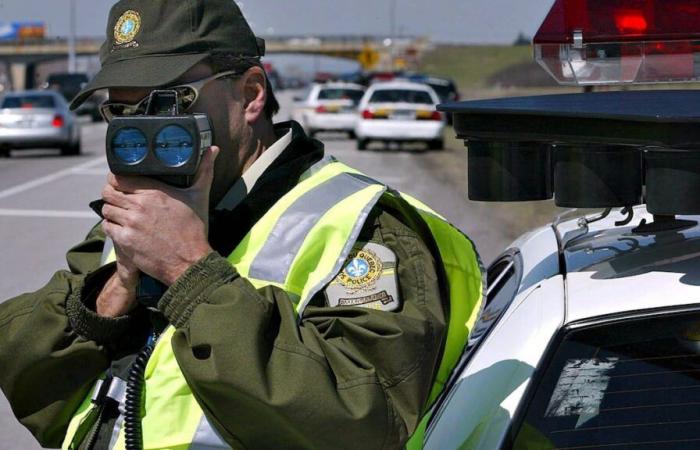No less than 208 Quebec motorists have been caught while traveling at at least 200 km/h since 2018, discovered The Journal. A speed at which it is almost “impossible” to react in time in the event of a problem.
• Also read: Here are the most dangerous drivers in Quebec
• Also read: Dangerous driving in Quebec: these incorrigible drivers who play Russian roulette
• Also read: His stolen car used in burglary
The fastest of them, Charles Barsikhian, reached the astonishing speed of 291 km/h on August 5, 2018, in Mirabel.
TOP 10: THE MOST PRESSURED
The offenses with the highest speeds captured
| Name and age | Place and date of the offense | |
|---|---|---|
| 1. | Charles BARSIKHIAN 36 ans | Mirabel August 5, 2018 |
| 2. | Darryl DAVANCE 23 ans | Saint-Jérôme June 25, 2022 |
| 3. | TIE IN ADVANCE 22 ans | Mirabel Jul 17, 2023 |
| 4. | Martin BOUGIE 52 ans | Saint-Marc-de-Figuery Jul 11, 2021 |
| 5. | Keith CAMPANA 25 ans | Saint-Lazare 08 nov. 2020 |
| 6. | Jocelyn GOUDREAU 54 ans | Saint-Étienne-de-Bolton June 7, 2020 |
| 7. | Yann BOURGUIGNON 34 ans | The Cedars Jul 1, 2021 |
| 8. | Valerie CINQ MARS 28 ans | Boisbriand 23 avr. 2022 |
| 9. | Stephane DELISLE 57 ans | Laval August 12, 2020 |
| 10. | Felix ALAIN 22 ans | Portneuf 02 oct. 2023 |
Source: Quebec Ministry of Justice
“At this speed, if there is anything on the road, it is impossible to avoid it,” underlines Pierre Bellemare, former reconstructionist of the Sûreté du Québec and expert in road collisions.
A car traveling at 100 km/h will take 80 meters to stop if the brakes are applied, considering the average reaction time of a person and a dry road surface.
In Mr. Barsikhian’s case, it would have taken him 525 meters to come to a complete stop if he had had to avoid a collision. “It’s a waste of time,” says Mr. Bellemare.
Similar cases will become more and more numerous, he believes, with the massive arrival of electric vehicles, more efficient and responsive than combustion ones. According to him, it would be wise to legislate to limit their performance upstream.
“Just like heavy trucks which are stuck at 105 km/h,” he says.
Maxime Brault, director of road safety research at the SAAQ.
Photo provided by the SAAQ
Drastic drop in offenses
When we look at all the statistics, however, the number of offenses for excessive speeding has fallen drastically over the past 15 years in Quebec.
Serious speeding incidents were around 40,000 in 2007, a figure which dropped to around 6,500 in 2023, according to the Société d’assurance automobile du Québec (SAAQ).
“The trend has been downward since we introduced more severe sanctions,” observes Maxime Brault, director of road safety research at the SAAQ.
This is because since 2008, the fines for these offenses, as well as the number of demerit points, have been doubled. Not to mention an immediate suspension of the license for varying periods of time.
But there’s still a lot of awareness work to be done, according to the experts we spoke to.
“It was successful, but it is certain that there are still people for whom the message does not get through. Data like that is unacceptable,” adds Mr. Brault, referring to data compiled by The Journal.
Pierre Bellemare, former SQ re-enactmentist and owner of L’team collision expert inc.
Photo provided by Pierre Bellemare
Raise awareness among young people
In all cases, it is in schools that efforts must be prioritized to raise awareness among young people of the risks of excessive speed and dangerous driving, believe the two experts.
“Young people no longer watch TV, advertisements about accidents have no impact on them,” laments Mr. Bellemare.
It is precisely for this reason that for the past ten years, the SAAQ has been going to schools to present collision simulations and show what high-speed accidents actually look like.
In 2023, collisions resulting in death among 15 to 24 year olds have increased by 31% compared to the average of the last five years.
“It remains to be seen whether it will happen again or if it was just a bad year,” concludes Mr. Brault.
Distance required to stop
- 50 km/h → 27 meters
- 100 km/h → 80 meters
- 150 km/h → 160 meters
- 200 km/h → 266 meters
- 250 km/h → 398 meters
Source: L’équipe collision expert inc.







